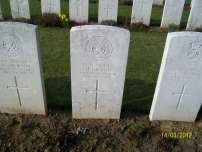| First Name: | John Henry | Last Name: | HERRING | |
|---|---|---|---|---|
| Date of Death: | 01/07/1916 | Lived/Born In: | Gunnersbury | |
| Rank: | Private | Unit: | London14 | |
| Memorial Site: | ||||
Current Information:Age-21 44, Wellesley Road, Chiswick Gommecourt British Cemetery2, Hebuterne, France
The opening day of the Battle of the Somme 1st July 1916 This was a disastrous day for the British Army in France. Eleven divisions of Fourth Army attacked along a 15 mile front from Maricourt to Serre. Two further divisions of Third Army launched a diversionary attack just to the north of Serre at Gommecourt. For a week beforehand the British artillery pounded the German trenches but the Germans had been there for a long time and they had constructed deep, concrete reinforced shelters beneath their trenches and many survived the bombardment. The troops went over the top at 7.30am but even before they had left their overcrowded trenches, many had been killed or maimed by German artillery. The Germans knew that they were coming. Once in No-Man’s-Land the artillery continued to take its toll and then the machine guns opened up on the advancing British infantry. They fell in their thousands and the attack came to a standstill almost everywhere. Survivors sought cover wherever they could find it and at night they crawled back to their own lines, often dragging a wounded soldier with them. Only in the south were any advances made with the attack on Fricourt and Mametz. Over 19,000 British soldiers were killed on this day, including 2,500 from London. The attack on Gommecourt The 56th (London) Division and the 46th (North Midland) Division carried out the diversionary attack on Gommecourt. It was intended to draw German reserves away from the main battle further south and to pinch out the Gommecourt salient. It failed on both counts. The German defences at Gommecourt were among the strongest any British attack faced on 1st July. Nevertheless 56thDivision’s attack on the southern edge of the salient began promisingly. The first two German lines were taken but they could get no further. 46th Division’s attack came to grief on the uncut wire and by the end of a very bloody day, all but the dead and injured were back in their own trenches. On 1st July, 1916, the 12th and 14th London battalions led the attack by 168 Brigade. They had a very wide stretch of No Man’s Land to cross and the German fire was so intense that very few made it across. One platoon of D Company were almost completely destroyed by German artillery even before they had got clear of their own trench. Especially deadly was a single light German gun (or pair of guns) enfilading from a hidden point 3000 yards south-east of the head of the Puisieux valley. However some did make it into the first two German trenches and there were even encroachments into the German third line. However, with the failure of the attack by 46th Division on their left, more and more German reinforcements were sent to oppose them and it was impossible to bring any reinforcements or supplies across. By early evening there were only about 70 of their number left in the German front line trench and within a few hours the last few survivors had made it back to their own lines. John Herring was one who did not survive the day. |
||||
| « Back to Search Results | ||||
| If you think any of the information shown here is incorrect, Click Here to submit your amends and comments | ||||




